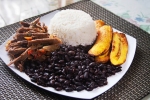September 2021
Celebrating Hispanic Heritage Month
The Holy and Human Process of Making Art
This article is also available in Spanish here. Este artículo está disponible en español aquí.
Who is this prodigal woman breaking her alabaster jar, letting this thing of great value spill into the world? A thing created carefully over time, hoarded and protected for just the right time, and here spent in a moment, extravagantly? As a disciple she shows us Mary, keeping that thing of value sheltered close while in her care, but always knowing it was not hers and it would be taken, given, with love, but also with cracking and cries.
 In this image the thing spilling out is not unfamiliar to the earth on which it falls – in fact, things like it grow all around, stalks of tall corn fading into the background against the late summer sun. No, this thing is transformative in its familiarity, a reminder that each instance births the world anew, each birth breaking open possibility, shedding its own light.
In this image the thing spilling out is not unfamiliar to the earth on which it falls – in fact, things like it grow all around, stalks of tall corn fading into the background against the late summer sun. No, this thing is transformative in its familiarity, a reminder that each instance births the world anew, each birth breaking open possibility, shedding its own light.
And we must kneel in the damp earth to hold it, to create the cocoon with our hands and our hair that will shield that joy, stoke it from spark to flame, and know we have already released what we hold by giving it life.
 How will we emerge from this wilderness, from our life hidden in the tree-shadows of our chosen blindness to confront these eyes? These are not faces of mean-spiritedness or foregone conclusions, but they are the furrowed brows of broken promises and the calloused cheeks of words said in earnest with weak-bodied follow through.
How will we emerge from this wilderness, from our life hidden in the tree-shadows of our chosen blindness to confront these eyes? These are not faces of mean-spiritedness or foregone conclusions, but they are the furrowed brows of broken promises and the calloused cheeks of words said in earnest with weak-bodied follow through.
We have eaten of the fruit of this tree, nonetheless, and we cannot unsee what we have seen. Retreating into the wild would be a child’s game of forts and make-believe, when there is work to be done in the city, under this bright sky and its brilliant sun.
The spirit waits for us, our white rabbit, not late, but conferring on us the same urgency to move toward a future we have not fully penned into our agenda. There is space in this crowd, but we will have to fight for it, we will have to want it, and we will have to join and stare out from the front at those we have yet to call into the work.
He wasn’t yet 35. He was no angel, neither were, but they were brothers to me. Their names carry more weight in my heart, perhaps because of their specificity to the lands our bodies hail from, Joseles and Itzolin. He, found naked behind a shopping center, and he, taking his own life; queer brown men who the world could not hold. I wish they were the full roster that tugs on my heart.
What was it to touch his body, distorted and mutilated, nails run through his hands, the mixed smells of waste and desert plants outside the city walls? What was it to feel not the heat of his heart but the cooling of his blood against the softness of your cheek? His body suddenly too large to hold, a thing already pulling itself down into the earth, splaying out and digging roots into the clay.
There is no consolation, no calming; wind and feather, cloud and rain cannot cool the outrage. Your choice to leave does not make leaving bearable. So hold me, but know that I won’t cease to cry.
 When I pick up a paintbrush it is always with trepidation. I know the path from the idea to the finished work will be winding and long and filled with both revelation and a good dose of frustration. There will be the hurry to cover every white inch of the stretched canvas, trapping its light and taking ownership over every moment the eye spends scanning its surface. There will be a tiny corner that catches something true and becomes an anchorhold. I work for hours to bring everything else level with that. Then that hold will give, and a new story will begin to emerge, and I must give up those strokes I was so in love with in order to make the whole thing work. Along the path, there will be the desire to express something poetic, elegant and abstract, immediately followed by the need to dirty it up and bring it back to the cracks, the tears, the relatable, visceral and real. For me as for most artists, I assume, it is not a clean or linear process, nor one that has an even temperament, but it is a holy one, a human one and definitely a Christian one.
When I pick up a paintbrush it is always with trepidation. I know the path from the idea to the finished work will be winding and long and filled with both revelation and a good dose of frustration. There will be the hurry to cover every white inch of the stretched canvas, trapping its light and taking ownership over every moment the eye spends scanning its surface. There will be a tiny corner that catches something true and becomes an anchorhold. I work for hours to bring everything else level with that. Then that hold will give, and a new story will begin to emerge, and I must give up those strokes I was so in love with in order to make the whole thing work. Along the path, there will be the desire to express something poetic, elegant and abstract, immediately followed by the need to dirty it up and bring it back to the cracks, the tears, the relatable, visceral and real. For me as for most artists, I assume, it is not a clean or linear process, nor one that has an even temperament, but it is a holy one, a human one and definitely a Christian one.
I hope these vignettes and images may spark in you a valuing of your own iconography, a wrestling with the symbols, images and words of our faith that breaks them open, finds hope but must be about the work of ever-recreating them. We are a tradition of rituals that hold ideas, but are not bound by them. May we break them open and explore their messy truth.
Jason Sierra is based in Austin, Texas, where he lives with his husband and their four foster children. He was a student of American and Feminist Studies at Stanford University and has an MBA from Duke University. A former graphic designer and member of Presiding Bishop Jefferts-Schori’s staff, he now works in public education leadership consulting for The Holdsworth Center.
Resources:
- Drawing Heaven by Anne Ditzler, an ECF Vital Practices blog, June 8, 2011
- Relationship Building: Through Art by Jeremiah Sierra, an ECF Vital Practices blog, May 5, 2014
- Love Listens by Alan Bentrup, an ECF Vital Practices blog, July 2, 2018
- My Spiritual Art Journey by Arnoldo L. Romero, Vestry Papers, September 2021






